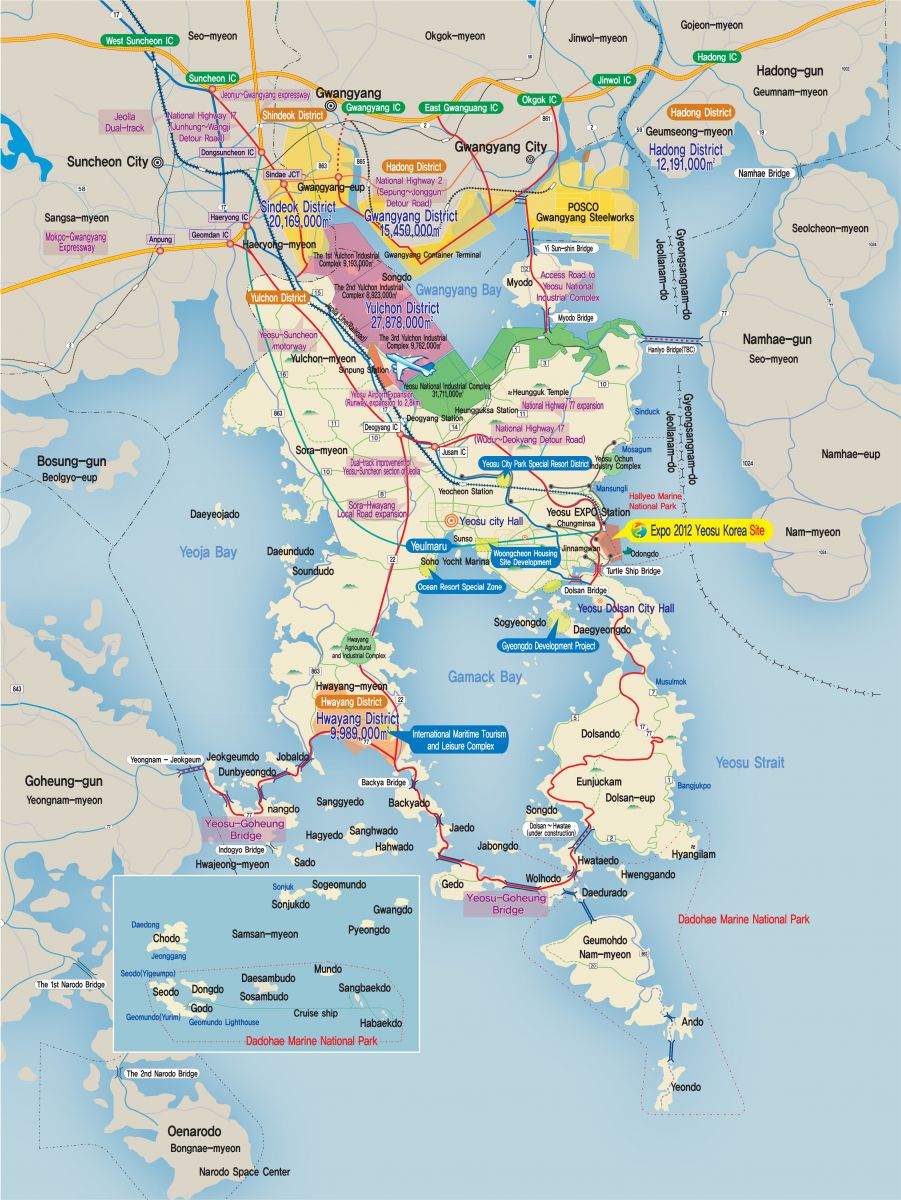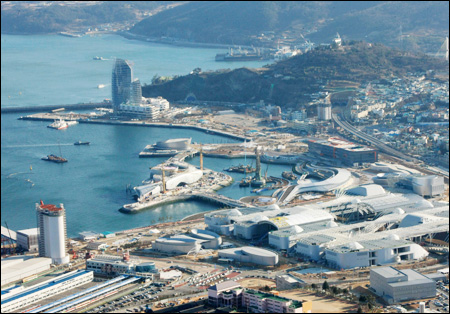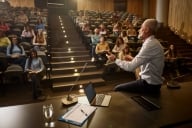You have /5 articles left.
Sign up for a free account or log in.
What to do when development strategies for a city-region change, but there is limited higher education capacity in said region? This issue emerged this summer when, following a work-related visit to Beijing in late July, I spent four fascinating days in Yeosu, a city of approximately 300,000 located near the southeast tip of South Korea.
The purpose of the visit was to participate in a Pacific Rim Council on Urban Development (PRCUD) Roundtable Forum regarding the future of Yeosu’s development strategy in a post-Expo 2012 era. PRCUD roundtables are structured somewhat similarly to the OECD’s missions regarding higher education and city-region development. By this I mean:
- Local host agencies (government, the private sector, community-based organizations) request an international ‘outside’ assessment of particular development challenges;
- Background documents are prepared for the visiting team;
- A visit to the city is held that involves meetings, Q&A sessions, debates, etc.;
- Preliminary findings are outlined in a wrap-up meeting;
- A final report is issued to the local host agencies.
While not gratis, this form of service is much more affordable than that provided by private consultants for the visiting team members provide their time for free because they value public service and find the exercise intellectually stimulating.
 Like many mega-event host city-regions, Yeosu has benefited from the improvement of its infrastructure, including rail and road systems, on and near the Expo 2012 site. It is also important to note that Expo 2012 is designed to facilitate change beyond the boundaries of the city itself, as highlighted in a part of a speech by former President Moo-hyun Roh during a International Exhibitions Bureau/Bureau International des Expositions (BIE) evaluative site visit to Yeosu in April 2007:
Like many mega-event host city-regions, Yeosu has benefited from the improvement of its infrastructure, including rail and road systems, on and near the Expo 2012 site. It is also important to note that Expo 2012 is designed to facilitate change beyond the boundaries of the city itself, as highlighted in a part of a speech by former President Moo-hyun Roh during a International Exhibitions Bureau/Bureau International des Expositions (BIE) evaluative site visit to Yeosu in April 2007:
Korea’s message in the proposed Expo 2012 is focused on the ocean and the coast. Yeosu will be the host city of Expo we are preparing and the event’s name will be Yeosu International Exposition, but we are hoping Korea’s south coast as a whole to be the proposed Expo’s main stage. We Koreans want to showcase this beautiful coastal belt to the world through Yeosu Expo... Let me add two more important meanings of our Expo bid. Korea is a country with large inter-city and inter-regional development gaps. Yeosu Expo will contribute to a more balanced territorial development in the country. In addition, the Expo will also able to act as a catalyst for inter-regional collaboration, cooperation and integration between southeast and southwest coastal regions. These two regions have a long history of political conflicts.
The above quote, as well as the following paragraph and map, were included in a briefing document we were provided with:
As such, the national government considered the Expo bid as a central project that could actualize an important regional policy and planning ideal known as ‘balanced national development.’ Since the early 1970s, the goal of balanced territorial development has been pursued in the country in order to spatially redistribute the benefits from industrialization concentrated in the Capital Region. Such exchanges might entail taking from Seoul-Incheon Corridor and surrounding Gyeonggi Province to provide less economically viable regions with varied development opportunities and incentives. In this regional policy context of South Korea, hosting an Expo in Yeosu was hoped to catalyze the development of economically distressed Jeonnam Province and the host city was expected to play a role as the central city in the country’s South Coast Sun Belt.
One of the interesting themes that emerged in the context of the meetings was inadequate higher education capacity in the Yeosu city-region. Yeosu – a city of 300,000 situated on the southern coast of South Korea – only has one small university. This university – known as Chonnam National University – was originally called Yosu University until it was merged with a larger regional university Chonnam University in March 2006. Given the merger, Chonnam National University now has a Yeosu campus (often known as the Doondeokdong Campus). This campus is not large, with 218 faculty serving 5,241 students. While I have not done a systematic comparison with other typical cities, it is worth noting that Chiang Mai University in Thailand serves some 25,000-30,000 students in a city of 160,000 (excluding the Chiang Mai regional population) while my own city (Madison WI) of 236,000 hosts two non-virtual universities serving 45,245 students.
A number of us on the PRCUD visiting team were surprised that the broad regional development agenda for the ‘South Coast Sun Belt,’ which is dependent upon a nurturing a vibrant Yeosu, had little to say about expanding opportunities to acquire a high quality higher education in the Yeosu city-region. The logic for doing so includes:
- Redress population loss through the influx of more students, staff, faculty, and visitors. For example, Yeosu is a wonderful location for international students (e.g., via study abroad schemes) such that visiting students would acquire a rich sense of Korean society while also enjoying an attractive coastal context.
- Facilitate structural change in the labour market through the provision of skilled labour, but also the development of the higher education component of the services sector.
- Facilitate the building of greater linkages with key sectors of the existing city-region economy. For example, there are limited ties and capabilities within Chonnam National University to engage with the Yeosu National Production Complex, as well as the nearby POSCO steel mill (the site of the world’s largest single producer of steel, with some 17-18 million tons rolling out per year, enough for the production of 22 million cars).
- Facilitate the development of new forms of knowledge (via research), knowledgeable people (via education), jobs, and firms regarding sectors and fields of such as marine science, tourism, renewable energy, gerontology, and so on.
- Facilitate life-long learning opportunities for an ageing society.
 What are the options for developing higher education and research capacity, perhaps located on the waterfront Expo 2012 site (pictured here, courtesy of Courtesy of Organizing Committee for EXPO 2012 Yeosu Korea)? There are many, assuming the Korean state was willing to sanction such a policy shift, and that the City of Yeosu (under the guidance of Mayor Kim Chung-Seog). To assist in some brainstorming, here are some modes of capacity building that are partially based on some case studies of new campuses in cities around the world:
What are the options for developing higher education and research capacity, perhaps located on the waterfront Expo 2012 site (pictured here, courtesy of Courtesy of Organizing Committee for EXPO 2012 Yeosu Korea)? There are many, assuming the Korean state was willing to sanction such a policy shift, and that the City of Yeosu (under the guidance of Mayor Kim Chung-Seog). To assist in some brainstorming, here are some modes of capacity building that are partially based on some case studies of new campuses in cities around the world:
- Expansion of Chonnam National University’s Yeosu campus. This could occur on the existing campus site or else via the development of an additional complex on the Expo 2012 site.
- Expansion of Chonnam National University’s Yeosu campus, though in partnership with a national or international higher education institution. This could occur on the existing campus site or else via the development of an additional complex on the Expo 2012 site.
- Establishment of new national (Korean) university branch campus in Yeosu. This could be done independently or in partnership with other national or international higher education or research institutions. Part of the logic is to generate some competition for Chonnam National University’s Yeosu campus. The Expo 2012 site is an ideal location for such a campus.
- Establishment of a new autonomous (Korean) university with the support of 1-2 existing national (Korean) universities, or else a number of international higher education or research institutions. Part of the logic is to generate some competition for Chonnam National University’s Yeosu campus. The Expo 2012 site is an ideal location for such a campus.
- Establishment of a new autonomous (Korean) university. Part of the logic is to generate some competition for Chonnam National University’s Yeosu campus. The Expo 2012 site is an ideal location for such a campus.
- Establishment of an international branch campus on the Expo 2012 site.
It is important to note that other modes of capacity building exist and that I have not outlined the strengths and weaknesses of each mode. A more thorough contribution would also identify key stages of the planning and implementation process, as well as case studies that have been both successes and disasters. Rather, this brief entry is merely designed to stimulate some further discussions and debates.
The expansion of higher education capacity in Yeosu clearly complements efforts to diversify the city-region economy, support the emergence of new or emerging sectors and related employment opportunities, and alter Yeosu’s reputation as the location of a massive national petrochemical complex. One of the key legacies of Expo 2012 is a large and very attractive waterfront space in the heart of the city, which is about to be vacated. The opportunity to expand higher education capacity one such an appropriate and attractive site is worth deliberating about, and quickly so that the site is not allocated to uses that may play a less relevant developmental role.







